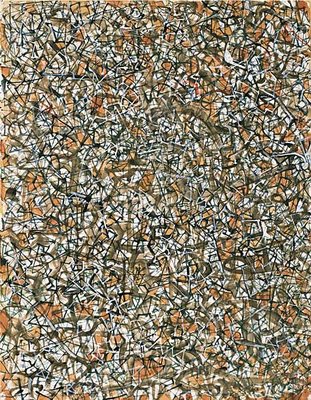 Advance of History, 1964. Gouache and watercolor on paper, 65.2 x 50.1 cm. Peggy Guggenheim Collection.
Advance of History, 1964. Gouache and watercolor on paper, 65.2 x 50.1 cm. Peggy Guggenheim Collection.Mark Tobey’s animated matrices of brushed line, like the mature works of Jackson Pollock, are allover compositions. That is, unlike conventional representational paintings, they have no discernable center of focus, no single emphasized portion. Even Cubist works maintain vestiges of pictorial illusionism through an increased density of form at their centers. Yet in viewing a work such as Advance of History, the eye moves easily from edge to edge without halting at any particular configuration, dipping, plunging, swirling, and doubling back to pursue the network of dynamic strokes that expand and breathe on the white surface of the paper. The support thus becomes but a portion of a composition that seems to extend beyond the physical limitations of edges or frames. As Tobey wrote, “I have sought to make my painting ‘whole’ but to attain this I have used a whirling mass. I take up no definite position.”1
Although the development of allover compositions in abstract painting is often associated with Pollock, Tobey in fact exhibited works without compositional focus or orientation as early as 1944, two years before Pollock made his first allover painting. In 1935 Tobey introduced his white writing, the characteristic network of white line that covers the surfaces of his works. This innovation followed Tobey’s discovery of Oriental traditions of ink brushwork in China and Japan, where he found himself “freed from form by the influence of the calligraphic.”2 The spontaneity and energy conveyed in his first white writing compositions is still evident in the Peggy Guggenheim work, executed nearly thirty years later. But the frenetic impulses of line in early examples, such as Broadway Norm of 1935 (Collection Carol Ely Harper, Seattle), have subsided into the more intricate and delicate fabric of lines of varying widths, densities, and color of Advance of History.
Elizabeth C. Childs
Mark Tobey was born on December 11, 1890, in Centerville, Wisconsin.
In 1918 Tobey converted to the Baha’i World Faith, which led him to explore the representation of the spiritual in art. Four years later he moved to Seattle and began teaching at the Cornish School of Allied Arts. Also that year he began to explore Chinese calligraphy. The artist went to Paris in 1925, beginning his lifelong travels. While in the Middle East in 1926, he became interested in Persian and Arabic script. From 1931 to 1938 he was resident artist at Dartington Hall, a progressive school in Devonshire, England. His tenure there was punctuated with frequent absences for travel to Mexico, the United States, and the Orient. Tobey spent a month in a Zen monastery outside Kyoto in 1934; the following year he began his “white writing” paintings, which were shown for the first time at the Willard Gallery, New York, in 1944.
Tobey died in Basel on April 24, 1976. more >
No comments:
Post a Comment